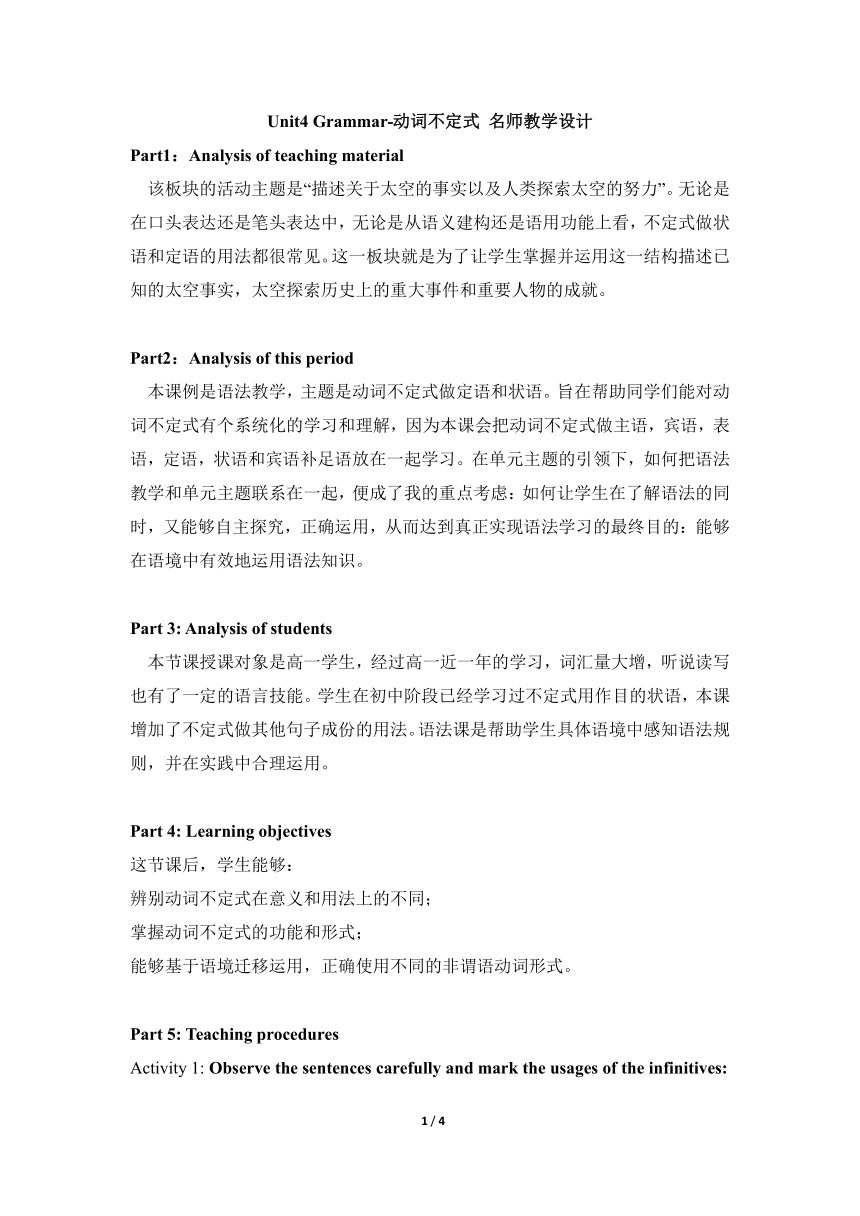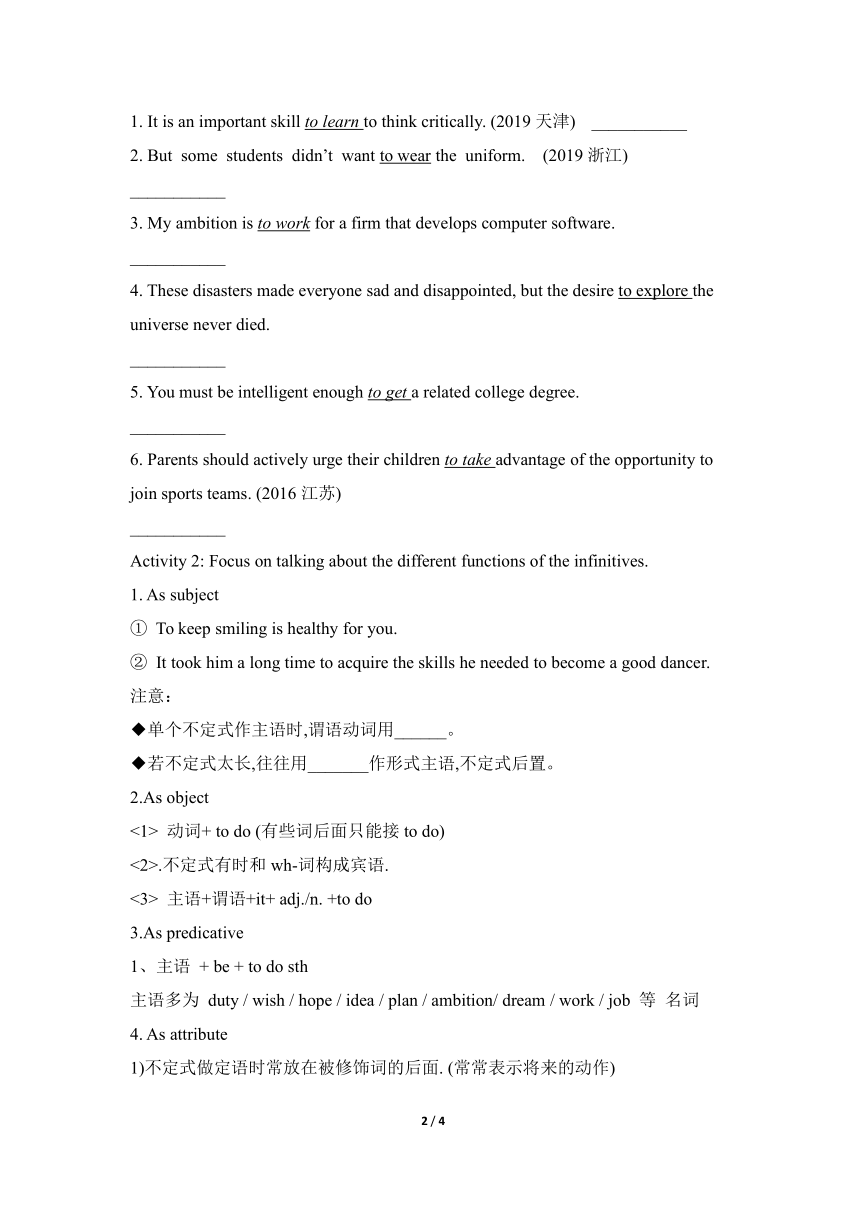人教版(2019)必修第三册 Unit4 Space Exploration Grammar-动词不定式 名师教学设计
文档属性
| 名称 | 人教版(2019)必修第三册 Unit4 Space Exploration Grammar-动词不定式 名师教学设计 |

|
|
| 格式 | docx | ||
| 文件大小 | 17.4KB | ||
| 资源类型 | 教案 | ||
| 版本资源 | 人教版(2019) | ||
| 科目 | 英语 | ||
| 更新时间 | 2023-03-10 20:13:29 | ||
图片预览


文档简介
Unit4 Grammar-动词不定式 名师教学设计
Part1:Analysis of teaching material
该板块的活动主题是“描述关于太空的事实以及人类探索太空的努力”。无论是在口头表达还是笔头表达中,无论是从语义建构还是语用功能上看,不定式做状语和定语的用法都很常见。这一板块就是为了让学生掌握并运用这一结构描述已知的太空事实,太空探索历史上的重大事件和重要人物的成就。
Part2:Analysis of this period
本课例是语法教学,主题是动词不定式做定语和状语。旨在帮助同学们能对动词不定式有个系统化的学习和理解,因为本课会把动词不定式做主语,宾语,表语,定语,状语和宾语补足语放在一起学习。在单元主题的引领下,如何把语法教学和单元主题联系在一起,便成了我的重点考虑:如何让学生在了解语法的同时,又能够自主探究,正确运用,从而达到真正实现语法学习的最终目的:能够在语境中有效地运用语法知识。
Part 3: Analysis of students
本节课授课对象是高一学生,经过高一近一年的学习,词汇量大增,听说读写也有了一定的语言技能。学生在初中阶段已经学习过不定式用作目的状语,本课增加了不定式做其他句子成份的用法。语法课是帮助学生具体语境中感知语法规则,并在实践中合理运用。
Part 4: Learning objectives
这节课后,学生能够:
辨别动词不定式在意义和用法上的不同;
掌握动词不定式的功能和形式;
能够基于语境迁移运用,正确使用不同的非谓语动词形式。
Part 5: Teaching procedures
Activity 1: Observe the sentences carefully and mark the usages of the infinitives:
1. It is an important skill to learn to think critically. (2019天津) ___________
2. But some students didn’t want to wear the uniform. (2019浙江) ___________
3. My ambition is to work for a firm that develops computer software. ___________
4. These disasters made everyone sad and disappointed, but the desire to explore the universe never died. ___________
5. You must be intelligent enough to get a related college degree. ___________
6. Parents should actively urge their children to take advantage of the opportunity to join sports teams. (2016江苏) ___________
Activity 2: Focus on talking about the different functions of the infinitives.
1. As subject
① To keep smiling is healthy for you.
② It took him a long time to acquire the skills he needed to become a good dancer.
注意:
◆单个不定式作主语时,谓语动词用______。
◆若不定式太长,往往用_______作形式主语,不定式后置。
2.As object
<1> 动词+ to do (有些词后面只能接to do)
<2>.不定式有时和wh-词构成宾语.
<3> 主语+谓语+it+ adj./n. +to do
3.As predicative
1、主语 + be + to do sth
主语多为 duty / wish / hope / idea / plan / ambition/ dream / work / job 等 名词
4. As attribute
1)不定式做定语时常放在被修饰词的后面. (常常表示将来的动作)
2).当名词被 the first ,the last, the only 等词以及形容词最高级修饰时:
3). 如果不定式是不及物动词,则后面需适当的介词:
① Please pass me some paper to write ____.
② She has a nice pen to write _____.
5. As adverbial
(1) 做目的状语,常用的结构: to do ; in order to do; so as to do
(2) 做结果状语 :表示出乎意料的结果,其前面时常有副词only. 常用于以下结构:only to…
(3)不定式做原因状语:
一般用在be+ adj. (表情感)后:说明产生这种情绪的原因.
6.As object complement
1) 动词 + 宾语(sb./sth.) + to do sth.
常用的动词有:ask; allow; advise; want; tell; order; teach; expect, require; cause; force ; permit ; encourage; urge;enable;warn; forbid; get; invite; persuade; remind; call on; depend on
2、动词+宾语+不带to的不定式
感官动词:一感:feel 二听:hear, listen to 五看:see, notice, watch, look at, observe
使役动词let, make, have
注意:◆但当以上的动词用于被动式,to要还原:
Activity 3: Focus on talking about the different forms of the infinitives.
形式 主动 被动
一般式
进行式
完成式
不定式的语态
<1>. It is a privilege for me ______________ to attend the meeting. (invite)
<2>. Everyone likes the hero__________________(praise).
<3>. He is very pleased to ________________(give)a chance to go abroad.
注意事项:主动形式表被动意义的不定式 !
1. 主语+be + adj.+ to do
能用于此句型的形容词有:difficult , easy, comfortable, fit, hard, pleasant, nice, good, interesting, heavy, dangerous, etc.
2. with sth to do (with复合结构)
3. want/need/require/deserve + doing / to be done
The house requires / needs / wants repairing.= The house requires /needs / wants to be repaired.
Activity 4: Consolidation.
Finish the following exercises related to the infinitives. (见导学案)
2 / 2
Part1:Analysis of teaching material
该板块的活动主题是“描述关于太空的事实以及人类探索太空的努力”。无论是在口头表达还是笔头表达中,无论是从语义建构还是语用功能上看,不定式做状语和定语的用法都很常见。这一板块就是为了让学生掌握并运用这一结构描述已知的太空事实,太空探索历史上的重大事件和重要人物的成就。
Part2:Analysis of this period
本课例是语法教学,主题是动词不定式做定语和状语。旨在帮助同学们能对动词不定式有个系统化的学习和理解,因为本课会把动词不定式做主语,宾语,表语,定语,状语和宾语补足语放在一起学习。在单元主题的引领下,如何把语法教学和单元主题联系在一起,便成了我的重点考虑:如何让学生在了解语法的同时,又能够自主探究,正确运用,从而达到真正实现语法学习的最终目的:能够在语境中有效地运用语法知识。
Part 3: Analysis of students
本节课授课对象是高一学生,经过高一近一年的学习,词汇量大增,听说读写也有了一定的语言技能。学生在初中阶段已经学习过不定式用作目的状语,本课增加了不定式做其他句子成份的用法。语法课是帮助学生具体语境中感知语法规则,并在实践中合理运用。
Part 4: Learning objectives
这节课后,学生能够:
辨别动词不定式在意义和用法上的不同;
掌握动词不定式的功能和形式;
能够基于语境迁移运用,正确使用不同的非谓语动词形式。
Part 5: Teaching procedures
Activity 1: Observe the sentences carefully and mark the usages of the infinitives:
1. It is an important skill to learn to think critically. (2019天津) ___________
2. But some students didn’t want to wear the uniform. (2019浙江) ___________
3. My ambition is to work for a firm that develops computer software. ___________
4. These disasters made everyone sad and disappointed, but the desire to explore the universe never died. ___________
5. You must be intelligent enough to get a related college degree. ___________
6. Parents should actively urge their children to take advantage of the opportunity to join sports teams. (2016江苏) ___________
Activity 2: Focus on talking about the different functions of the infinitives.
1. As subject
① To keep smiling is healthy for you.
② It took him a long time to acquire the skills he needed to become a good dancer.
注意:
◆单个不定式作主语时,谓语动词用______。
◆若不定式太长,往往用_______作形式主语,不定式后置。
2.As object
<1> 动词+ to do (有些词后面只能接to do)
<2>.不定式有时和wh-词构成宾语.
<3> 主语+谓语+it+ adj./n. +to do
3.As predicative
1、主语 + be + to do sth
主语多为 duty / wish / hope / idea / plan / ambition/ dream / work / job 等 名词
4. As attribute
1)不定式做定语时常放在被修饰词的后面. (常常表示将来的动作)
2).当名词被 the first ,the last, the only 等词以及形容词最高级修饰时:
3). 如果不定式是不及物动词,则后面需适当的介词:
① Please pass me some paper to write ____.
② She has a nice pen to write _____.
5. As adverbial
(1) 做目的状语,常用的结构: to do ; in order to do; so as to do
(2) 做结果状语 :表示出乎意料的结果,其前面时常有副词only. 常用于以下结构:only to…
(3)不定式做原因状语:
一般用在be+ adj. (表情感)后:说明产生这种情绪的原因.
6.As object complement
1) 动词 + 宾语(sb./sth.) + to do sth.
常用的动词有:ask; allow; advise; want; tell; order; teach; expect, require; cause; force ; permit ; encourage; urge;enable;warn; forbid; get; invite; persuade; remind; call on; depend on
2、动词+宾语+不带to的不定式
感官动词:一感:feel 二听:hear, listen to 五看:see, notice, watch, look at, observe
使役动词let, make, have
注意:◆但当以上的动词用于被动式,to要还原:
Activity 3: Focus on talking about the different forms of the infinitives.
形式 主动 被动
一般式
进行式
完成式
不定式的语态
<1>. It is a privilege for me ______________ to attend the meeting. (invite)
<2>. Everyone likes the hero__________________(praise).
<3>. He is very pleased to ________________(give)a chance to go abroad.
注意事项:主动形式表被动意义的不定式 !
1. 主语+be + adj.+ to do
能用于此句型的形容词有:difficult , easy, comfortable, fit, hard, pleasant, nice, good, interesting, heavy, dangerous, etc.
2. with sth to do (with复合结构)
3. want/need/require/deserve + doing / to be done
The house requires / needs / wants repairing.= The house requires /needs / wants to be repaired.
Activity 4: Consolidation.
Finish the following exercises related to the infinitives. (见导学案)
2 / 2
